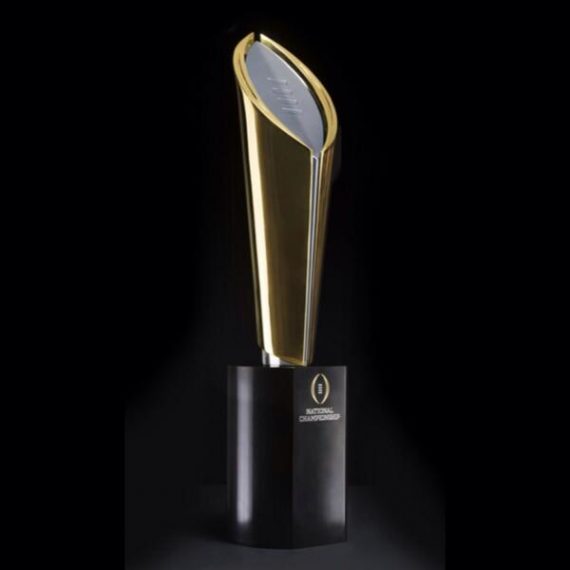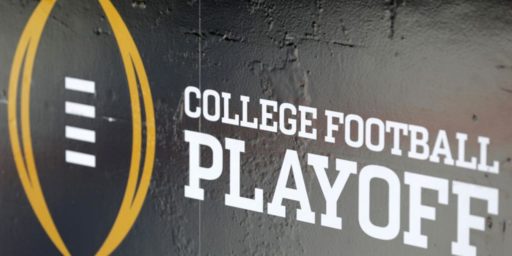The New College Football Playoff System Won’t Be Any Better Than the B.C.S. Was
The B.C.S. was far from perfect, and the College Football Playoff system will be, at best, only slightly better.
Last night, the committee that will ultimately decide the four teams that will meet for the playoffs that will end in a National College Football Championship Game in January released their first set of rankings last night:
The College Football Playoff selection committee revealed its first set of rankings Tuesday night, placing Mississippi State, Florida State, Auburn and Mississippi as its top four teams, in that order.
The 12-person committee met Monday and Tuesday in a conference room at the Gaylord Texan hotel near Dallas to debate the merits of each team and then determine its top 25. The top four teams when the final rankings are released on Dec. 7 will gain entry into the inaugural playoff.
While Mississippi State and Florida State are undefeated, Auburn and Mississippi each have one loss. Rounding out the committee’s top 10 were other one-loss teams in No. 5 Oregon, No. 6 Alabama, No. 7 Texas Christian, No. 8 Michigan State, No. 9 Kansas State and No. 10 Notre Dame.
The committee’s top four did not mirror those selected by The Associated Press this week: in that ranking, Alabama was third and Auburn was fourth.
The highest-profile team to lose the most spots between the A.P. poll and the committee’s was Notre Dame, which slipped from No. 6 to No. 10.
The biggest beneficiaries of the committee were Mississippi (A.P.’s No. 7), which is coming off a 10-7 loss at Louisiana State, and Texas Christian (No. 10). Placing Mississippi above Alabama most likely reflects an emphasis on head-to-head results — the Rebels beat the Crimson Tide, 23-17, on Oct. 4.
In an interview on ESPN minutes after the rankings were released, Jeff Long, the committee’s chairman and Arkansas’s athletic director, stressed that the members looked at teams’ complete body of work.
“It’s important for me to point out we really don’t look at it as a conference,” Long said. “We look at those teams, we analyze the teams they played, and we looked at the successes they had, the failures they had.”
The final rankings, released the Sunday after several conferences hold their championship games, will determine the composition of the six playoff-affiliated bowls, including the two semifinal bowls.
There are many more weeks of action left to jumble the playoff picture. Four of the top six teams are in the Southeastern Conference’s West Division, and there are several matchups between them, including Auburn’s game at Mississippi on Saturday night.
Tuesday’s rankings were nonetheless intensely anticipated because they offer the first glimpse at what the committee will place value on before it decides the final four.
There will undoubtedly be much debate about these rankings, and the ones that will follow between now and the final list that is released in December, but it strikes me that my initial opinions about the new system are being borne out. Most of the complaints about the Bowl Championship Series appeared to center around the fact that the formula that it used didn’t take things like strength of schedule and other factor into account sufficiently enough and that it often seemed to benefit teams that were in one of the big conferences at the expense of lesser known schools such as Boise State and Baylor that had comparable records but were often ranked lower for reasons that seemed to be arbitrary. In the end, though, it isn’t clear to me how a playoff selection system based on a committee like this can be any less arbitrary than the BCS computers allegedly were. Defenders of the idea of the new system, or of the idea of expanding it to eight teams instead of just four, argue that such a system is better than what we had with the BCS, but as I noted when I wrote about the new playoff system when it was announced, it’s rather obvious that fans are going to be just as disappointed with this system as they were with the BCS:
The computer-based system, taking into account different polls as well as other factors, was intended to have been an objective way to determine rankings between teams that play inherently different schedules in different leagues, and often different styles of football. It was inevitable that fans of teams that would lose out under such as system, such as recent years when Boise State was often placed far down in BCS Rankings largely on the basis of “Strength Of Schedule.” The first time that a similar situation happens to a team that is ranked at 5th or 6th, or 7th or 8th for that matter, you’re going to hear similar complaints about this new system as well.
In the end, though, I’m not sure there is such a thing as a perfect answer to this kind of “problem.” Expand this to a six team playoff and you’re going to get the same criticisms from fans of teams on the bubble. Indeed, you often do hear such criticisms after the selections for the NCAA basketball tournament, although its far less common mainly because that is a 64 team (plus play-in games) tournament. Of course, a 64 game football playoff would be unworkable and I’ve got to think that anything beyond 6 or 8 games wouldn’t work all that great either. After all, the NCAA and the conferences do have to keep in mind that, as the schedule moves in to December and January, they are going to be competing for television time with the NFL Playoffs.
And, yesterday, FiveThirtyEight’s Neil Paine argued quite strongly that the BCS wasn’t any worse than this system will be no matter how many playoff games there are:
The BCS, which mixed polls with the supposed objectivity of computers, was supposed to fix all that. The existence of mathematical ranking systems in college football dated back at least 70 years prior, but since the AP began continuously issuing polls in 1936 these systems had never been the game’s preeminent selectors.
It didn’t go smoothly. The computers became an easy punching bag for everything that fans and media hated about the BCS as a whole. “I think over the years, the computers were a scapegoat,” algorithm-maker Richard Billingsley told ESPN’s Mark Schlabach in August. “If there was an issue or if somebody didn’t like the results, it was the computers’ fault, and that wasn’t fair at all.”
(…)
perhaps the BCS’s biggest sin of all was banishing computer rating systems that took into account a team’s margin of victory in its games. It was seeking to reduce the incentive for coaches to run up the score on overmatched opponents, but in doing so it also deprived the computer ratings of key data points. One of the most crucial findings in sabermetrics, across virtually all sports, is that the average margin by which a team wins or loses conveys more information than wins and losses alone. This is especially true in a sport like college football, where the sample of games is so small.
Perhaps a computerized system could work if it were deployed with more skill. But college football’s decision-makers have decided instead that using no data — or at least a fuzzy interpretation of what’s available — is better than rigidly adhering to a defective model.
And it may not make much of a difference.
There will likely be a great deal of crossover between the playoff committee’s selection and the teams the BCS would have listed in its top four slots. In the estimation of SB Nation’s Bill Connelly, no fewer than 75 percent of the top four teams in the BCS rankings each year from 1998 to 2012 — and probably closer to 85 percent to 90 percent — aligned perfectly with the teams a hypothetical playoff committee would have selected had the current system been in place over those years.
There also isn’t much distinction between the BCS’s and the CFP’s accuracy in determining the nation’s true best team. The CFP’s four-team bracket would be more likely to feature the deserving champion (a four-team playoff system has about a 45 percent greater chance of including the best team than a two-team setup like the BCS). But the CFP loses that advantage by forcing the top team to play an additional game, opening it up to becoming the victim of bad luck. According to past research of mine, a two-team playoff is won by the best team in the country about 29 percent of the time, while a four-team playoff crowns the best team at a 31 percent clip — hardly any improvement at all.
Theoretically, those numbers would increase slightly if the playoffs were expanded to six or eight teams, but I would suspect that it wouldn’t improve by all that much, and that instead of the complaints of the fans of the teams that get ranked fifth through eighth at the end, we’ll be hearing the complaints of the fans ranks 9th through 12th, and so on down the line. In the end, given how different the schedules of all of these football teams are, the fact that there are far fewer games up on which to judge performances in football than there are in basketball, the fact that you could never really have the kind of massive round robin tournament for football that basketball has, and other issues such as contractual and other obligations that require teams that could potentially be ranked higher to play FCS Division and lower ranked teams, it’s just not possible to come up with anything approaching an objective list of contenders for the best college football team in the country. Some people have suggested the idea of giving preference to conference champions, but even that idea has its flaws for many of the same reasons I mentioned above. Eventually, though, if conference consolidation continues as it has over the past decade or so, that may be exactly where we’re headed, or alternatively we may see the “big” conferences —- SEC, Big Ten, Big 12, and the PAC-12, — expand even further and create their own championship series outside the NCAA.
In any case, the new playoff system is likely to be with us for some time. There will likely be some reforms made along with way, much like there were reforms made to the B.C.S. about halfway through its run, but it’s not going to eliminate the controversies any more than various rule changes on the field eliminate controversies that erupt when the fans or one team or another complain about a “blown” call. The B.C.S. wasn’t perfect, but it was better than what preceded it if your concern was for some kind of designation of an “objective” national champion. The new system is, at best, only slightly better it seems and demanding perfection that can never be attained seems rather silly.







Clearly, this is Bush’s fault.
Wasn’t the BCS created in the first place after somebody like Brigham Young won the “national championship” in the polls, implicitly to ensure that schools like that would NEVER be able to do it again?
Mike
I actually doubt the new system will be with us long. It’ll be 8 teams, then ten, twelve, etc because everyone thinks if you just move the first base to 91 feet you won’t have those pesky ties.
That and the money.
The FCS has over 20 teams in its playoff.
@Trumwill:
I think when Ohio State has to go to Boise Idaho in December to play in front of a half full stadium that the idea of a 16 team or greater playoff will fall apart. The only way to expand the playoffs will be to reduce the regular season and I do not see any of the SEC or Big 10 teams wanting to give up their 7 home games a hear in order to play road games in the middle of December.
You guys are of course correct that the teams on the bubble will always complain, but it’s ridiculous to argue that increasing the championship contenders from 2 to 4 isn’t an improvement. It’s quite possible to have 3 undefeated teams (and IIRC, it’s happened more than once). It’s very very unlikely for there to be 5 undefeated teams.
Sorry, but once you lose a game, you’ve given up control of your fate to someone else. I don’t have a problem with this.
Nope, it’s an improvement. People always will complain about the last team out, but it’s a lot more relevant when the last team out has a chance to win it all.
In the men’s basketball NCAA Tournament, the last at-large teams in are generally around 11 seeds. 11 seeds have made the Final Four before (LSU 1986), and quite a number of 8 seed have. Six seeds have won it. Reduce the field to 48 like it was and at large 8 seeds would be excluded (assuming you kept the auto bids for conferences.) That would be too small. People complain about the current setup of who gets in, but no one realistically believes that the last team out could win it all.
There have frequently been years when the third team in the BCS had a legitimate case to be the best team. It will be less likely for the fifth team. Eight is probably the proper number of teams for football; never will the eighth place team be considered a serious contender for best.
@superdestroyer: Boise State is a poor example, because they can and do fill their stadium. Actually, for playoffs, even Eastern Michigan might fill their stadium, especially if they were playing an Ohio State type team. Plus, I’d expect the lesser-conference teams to be lower-seeded anyway, meaning that they’d be traveling to Columbus.
That said, I do think the lesser conferences are a sticking point to a more inclusive playoff. An advantage to a four team playoff is that you can all but leave them out entirely. That gets harder with eight, and next to impossible with 10-24.
On the other hand, what happens when an undefeated Big Ten champion doesn’t get in to make room for a third SEC team? An inconvenient thing is that one of the most prestigious of the P5 conferences is also the weakest of them.
@John Thacker: As playoffs expand, it becomes less about picking the absolute best team and more about making the playoffs, whether you have a reasonable claim to the title of “best team” or not.
@Trumwill: 8 teams with automatic spots for the Power 5 conf champs provided they have a championship game. This will force the Big 12 to expand but they want to anyway. Once you do that then the conf championship games are the the first round of the playoffs. The last 3 teams could be at large but I would argue you should have 3 play-in games to determine the spots. These games should be limited to conf champs other than the power 5 and indies (of which there are very few)
Then you have a 16 team playoff with no more than 1 team per conf. Which is what it should be. The whole season then is a tournament like the world cup with round robin games early and single elimination late.
The worse outcome you can have in any system is what happened in 2011 when the team that was ‘crowned’ national champions could not even win its own division much less conf. Makes a mockery of the whole regular season.
@John Thacker:
“Six seeds have won it”
8th seeds have as well (Villanova, 1985).
@Will Truman:
I used Boise State because they have been in the top 10 before. Also, I think that no one is thinking about the logistics of having a playoff game on December 20 2014 when the last day of classes was on December 12, 2014. Keeping the band, cheerleaders, trainers on campus for a week after classes have ended along with winter travel plans are much different. One of the tricks of the bowl games is that they occur 40 days after the end of the football season and March Madness is no comparison because so few student travel to the games.
@Will Truman:
If college football becomes about making the tournament and not winning, then you can forget having interesting non-conference games. All of the conferences will have to follow the SEC model where they refuse to play good teams in a home and home schedule.
The Power 5 conferences will schedule cream puffs for non-conference games and then play their conference schedule. Winning a conference will probably most be a function of home and away games in conference. Notre dame would have to joint a conference for football because no one else would schedule them.
@jib: Politically, it’s just not possible to limit the tournament to conference champions. The top conferences will always argue that their castoffs are better than other conference champions, and they’ll usually be right.
If I were devising a larger playoff, it would include the top six conference champions, and three non-champs.
Ideally, I’d like the six conference champions to be chosen by a formula. Most specifically, the conference champions from the three best conferences (top to bottom) regardless of their records, and then the three highest ranked conference champions besides. But as long as the conference champions weren’t hard-coded (say the P5+MWC or P5+AAC), I’d be okay with that.
@superdestroyer: I think most of the logistics have been settled at the FCS level.
I also don’t think it would adversely affect scheduling much. I mean, I’d love to cite that as a reason to be against it, but if anything it might have a positive effect on scheduling. The best of the best teams right now have to worry about a single loss keeping them out of the championship. That wouldn’t be the case with a playoff. A single loss isn’t as devastating. (Which points to the real drawback, which is that with each incremental increase in playoff slots, the less the regular season matters.)
@Trumwill:
FCS does not compare. The visiting team does not bring any fans. The weather is not important for teleivsion because they play more of the games during the week. The playoff is finished before Christmas. The vistiors do not bring their bands or anything other than a few cheerleaders. The squads are smaller and thus, travel is easier. Look at the smaller bowls where the schools do not bring their bands, their fans, or any interest when played in December.
Auburn or Tuscalosa Alabama may be great sports when school is in session but what happens on December 20 when the dorms have been closed for a week and most of the students have gone home?
@superdestroyer:
Alabama is crazy about their football – trust me, they would be full for a playoff game in July heat or December cold.
The half measure isn’t better than the full measure, but it’s definitely better than the BCS.
The BCS has already seen its system blow up multiple times. Which is why we are at where we are at. Theoretical comments about who may be upset with the new system completely ignores what’s already transpired.
03/04 had USC and LSU getting first place votes in the AP poll.
04/05 had 3 undefeated teams, with 2 getting first place votes in the AP poll
07/08 had LSU, Georgia, USC and Kansas all getting first place votes in the AP
10/11 leaves 2 undefeated teams one of them being a TCU that beats a number 5 team in their bowl game
So the BCS can’t even get right the very thing it was meant to get right. We aren’t talking about on the bubble teams not making the championship game… the BCS can’t even get enough credibility to undisputedly crown the national champion after their “championship” game.
Saying the playoff system is marginally better is contrarian nonsense.
@aFloridian:
They may fill the stadium but the atmosphere would be very different. Fewer students, more hangers-on. Also, most “crazy” fans are really just bandwagon fans. When Alabama was going 6-6 with Mike Shula, no one talked about the crazed fans.
The solution to this has long been obvious. Take 8 teams (preferably only conference champions). Match them up in the traditional Big Bowls (e.g., Rose Bowl is Big Ten vs. Pac Ten; Sugar Bowl is SEC). Take those four winners and play them off. Keeps tradition, keep the field a decent size and, by only taking conference champions, you keep the regular season meaningful.
@Hal_10000:
The are more than eight conferences. Not all of the conferences are equal is quality. The conferences are different sizes. Conferences do not all play the same number of conference games.
A version of your plan would be to reduce college football to 64 schools in four conferences. The conference championships become the defacto first found and the four conference champions play for a championship. The schools that current play FBS (Div I-A) would either have to move down to FCS (Div I-AA) or give up football. Also, scheduling would be easier where every school plays nine conference games and one each from the other three conferences. Of course, since such a system will not allow the big time teams to have seven home games every year and not allow them easy wins against creampuff teams, it will never happen.
@superdestroyer:
I don’t see why your fears don’t apply to the BCS system. A playoff system that favors the power conferences is merely more explicit in it’s favoritism. The BCS system still screwed schools in mid-majors like TCU. Now, I agree that a playoff system would have to have at least 2 at-large bids to account for independents, mid majors, and really good one loss power conference teams. But this idea that FBS football would collapse if it had to labor under the same restrictions as every other sport in existence is ridiculous.
@Console:
March madness is a tournament of 68 schools drawn from abour 320 schools. The BCS playoffs is now a tournament of four schools drawn from around 120 schools. Expanding to 8 schools does not help much. In addition, playing one game a week (max) at home locations is very different than 2 or 3 games a week at a neutral location.
@superdestroyer:
I think 8 schools helps a great deal if the focus is on conference champions. For me, ideally it would be: Pac-12, Big 12, Big 10, SEC, and ACC champions, one other conference champ based on conference strength, 2 at large bids.
Bowl season is such a drawn out cash grab that the idea a playoffs is logistically hard is hard to buy into. The FBS already has more money and built in neutral bowl locations with payouts. If the FCS can make do with less, then there is nothing stopping the FBS. I guarantee you that no FCS school is getting 4 million dollars just to show up at a playoff game.
Logistics has never been the problem. The BCS is simply more about protecting the brand of the participating schools than it is in producing a competitive product.